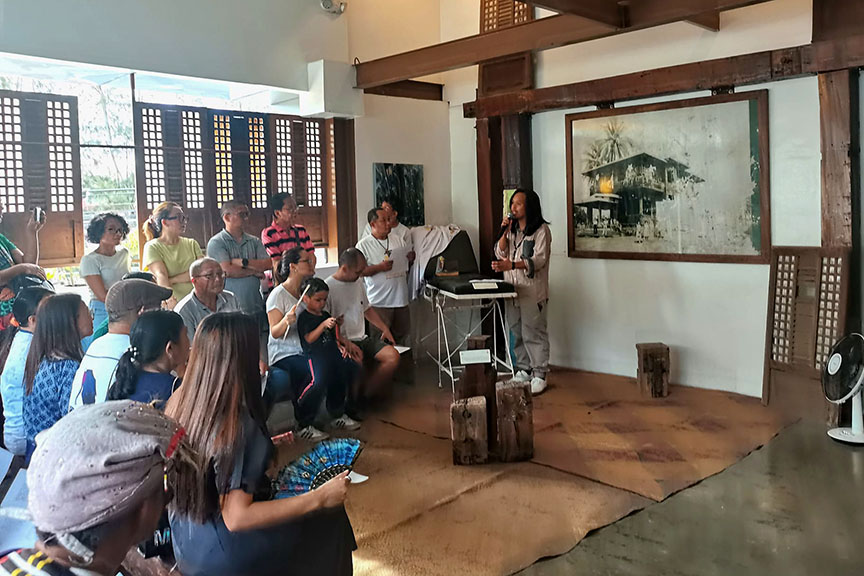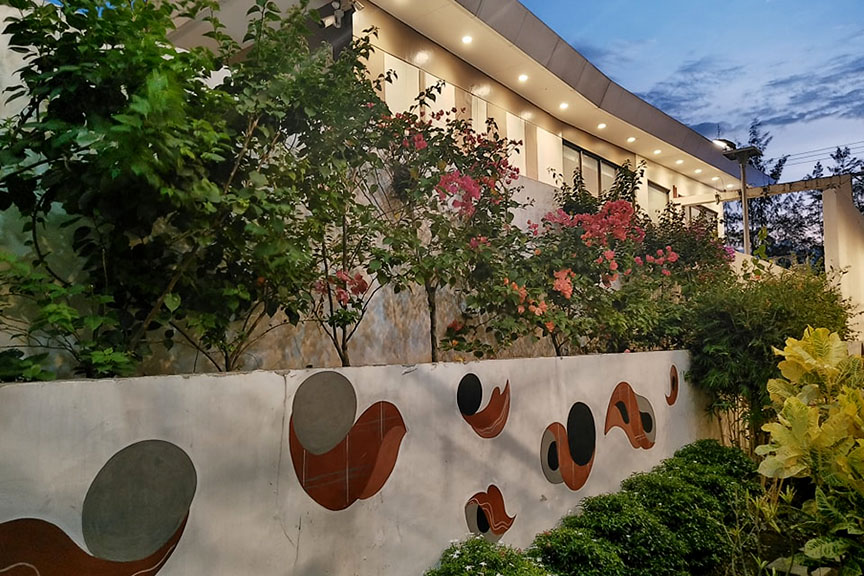
(What follows is the Inaugural Madriguera Lecture, which I delivered on the occasion of the opening of the Masbad Gallery in Kidapawan last 28 April. The past month has been hectic, preventing me from contributing to this column as often as I would like. One of the major preoccupations has been the setting up of the gallery, which I am curating and which features a memorial to the late Kidapawan mayor, Dr. Alberto Madriguera, and his wife Teresita. The gallery and the building both deserve their own articles, but for now, I share the lecture to the public.)

KIDAPAWAN CITY (MindaNews / 30 April)—What can a town do when it does not have any heritage?
This question first became relevant in Kidapawan in 2019.
Then City Mayor Joseph Evangelista was having a conversation with National Commission on Culture and the Arts (NCCA) representatives who had given a three-day training on cultural mapping and who were paying him a courtesy visit.
Manong Joseph lamented that Kidapawan did not have a heritage zone—nothing like Vigan, or Silay, or Kyoto, or the European capitals, or other concentrations of heritage properties.
It is a predicament many towns in Mindanao know all too well.
For the longest time the dominant mindset has been what is good is what is new, the old is something we move on from, discard, demolish.
Now we are beginning to suffer the repercussions.
Heritage-rich towns around the world continue to earn millions in cumulative revenue annually from heritage tourism, income that places like Kidapawan are missing out on.
These places have distinct identities that help with branding, giving their local businesses a boost (in contrast with Kidapawan still struggles to articulate its identity as a town).
And the genuine pride of place is keeping these towns’ most skilled people connected to them, far cry from the brain drain Kidapawan continues to suffer.
We recognize the challenges of heritage conservation, especially for built heritage structures—keeping an old building intact is costly, it is hard to find the specialized skills needed to pull it off, and it limits how you can use a building. The odds are stacked against adaptive reuse.

But here in the Madriguera Building, the Masbad family has created what may be an exciting way forward—to imagine adaptive reuse and heritage conservation in intangible terms, as a primarily creative exercise.
No matter how much Manong Bingo might have wanted it, keeping the old Madriguera Mansion intact was not viable.
But being the visionary that he is, he saw that while he may lose the physical house that he grew up in, the idea of it will forever live on in his heart and in his memories.
And so came the idea of building a new structure, but one which uses parts of the original house and retaining its identity.
If you cannot conserve the tangible, you assert the intangible.
While the original Madriguera Mansion may be gone, there are still enough of the components left to keep it alive: the location, the design (these capiz shell windows on the corner are meant to replicate their original position in the mansion), and these pieces of wood and windows from which, almost talisman-like, the very concept of the building emanates.
But more importantly, there is still the attachment with which Nong Bingo calls this space home, an attachment he inherited from the Madrigueras and which he now passes on to Kuya Wacky, Kuya Adiel, Ate Elian, Micah, and me.
We note, of course, that there are precedents to this. The Masjid Karim Makdhum in Simunul, Tawi-Tawi—the oldest mosque in the Philippines—was first built around 1380, but the current structure only dates to the 1960s. The building lives from its location, the four old pillars that have been kept intact over the centuries, and the devotion of the locals to the memory of the Masjid.
I argue, however, that this is a distinctly Kidapawan approach to adaptive reuse, and it is a practice shared by all three of Kidapawan’s peoples.
Not far from here, the Moro Abubakar family rebuilt their home using the wood salvaged from the mansion their father once built.
And up in the MADADMA ancestral domain we have found Monuvu houses built after the 2019 earthquakes using wood that goes back a century.
If you can’t save an old building, why not tear it down but reuse the materials from it in the new building, keeping the memory of the original alive—cheap, easy, imaginative, but full of sentimentality?

That the Masbads assert that this building was founded in 1949 is a stroke of Kidapawan genius. It means that this building is rooted in the past, but more importantly that the past will be taken into the future.
And to the future we will take it. Because as Nong Bingo made memories in the old Madriguera Mansion, future generations will now make memories in the Madriguera Building.
This is at the heart of the Masbad Gallery’s curation. We have invited artists to come and make art that would resonate with the Greater Kidapawan Area—the vast historical town Dr. Alberto Madriguera once led as its mayor.

Just as the Madrigueras who hail from Laguna and the Masbads who have roots in Leyte came to know this Mindanawon town intimately, so to do we hope that the artists who contributed to the gallery will start a relationship with Kidapawan.
And for the Kidapawan public, the gallery continues in some way the spirit of many of the Madriguera Mansion’s functions.
It had served as Dr. Alberto’s informal office as public official, where people can come and discuss issues. Today, through the gallery, that political legacy lives on: we reflect on the impact of the imposition of uniform colors on the tricycles with Bing Carino’s MinTODA, or we take a sobering look at the violence we still sometimes see in Patadon or Matalam with Vic Dumaguing’s painting down the hallway.
The mansion also once served as clinic for both doctors—we even have Dra. Teresita’s delivery bed here today. That medical tradition is continued in Glenn Agallano’s raising awareness about HIV with two of his photos, and the healing of course comes (we hope at least) with the therapeutic power of art.
But more importantly, the mayor’s home was a community center, where people came to meet, be entertained, and enjoy one another’s company.
I imagine that dancing must have once happened in the parties commemorated in these photographs during Manong Bingo’s several-day birthday bash. That dancing spirit is what Jhonrey channels both in his paintings and in sections of his mural.

We don’t know what other resonances the public will have with these artworks, and that makes it all the more exciting!
We have deliberately put the historical wood and the artworks in the building near the commercial spaces. The transactions of the tenants and their clients are as much a part of the curatorial experience as these items—this makes the historical and creative accessible, but it also makes daily life here special.
Just as art is not merely hung on the walls as décor but relished and experienced, heritage is not just taxidermied and displayed. It is lived.
Heritage is often seen as something terminal—a matter of “preservation,” and “keeping things as they are.” To some extent that may be true. But we here in the Masbad Gallery believe that heritage must also be dynamic, because at the very heart of heritage is collective loving, and loving is a necessarily active, participative, collaborative, and creative thing.
And who are tasked in society to lead the process collective loving but the artists?
We envision a Heritage-Art continuum, whereby creative expression generates heritage, and heritage sustains and enriches creative expression.
This building demonstrates it best: with creative curation, a mansion emerges from some pieces of old wood and a few good memories.
Rubble becomes paint for the walls, salvaged floor planks become signage for the tenants. The young is given the dignity of legacy, the old is revitalized with renewed relevance. This delivery bed might even end up being used again!

I curated this centerpiece to suggest a fire—both an eternal flame to keep the building’s soul burning, and a bonfire around which we gather as community to listen to stories. It will burn for ages, but will always give warmth to the moment. Perhaps we can roast some Kulibpos over it, or smith some blades or fire some pots.
The fire is the perfect metaphor—heritage keeps warm, brings people together, cooks and kilns, and it is not preserved. It is cultivated, kindled.
There perhaps is the answer to Manong Joseph’s quandary—to set this town on fire with heritage. Slowly start building that heritage zone one hearth at a time, starting from this building and radiating out into this whole historical promenade facing the Pine Trees.
So that when decades have passed and lives have been lived here, we have created for ourselves and our descendants an intangible heritage zone, a whole district of immortal buildings erected in the heart.
What do you do when a town does not have heritage? Well, you go about kindling it.
(MindaViews is the opinion section of MindaNews. Karlo Antonio G. David has been writing the history of Kidapawan City for the past thirteen years. He has documented seven previously unrecorded civilian massacres, the lives of many local historical figures, and the details of dozens of forgotten historical incidents in Kidapawan. He was invested by the Obo Monuvu of Kidapawan as “Datu Pontivug,” with the Gaa (traditional epithet) of “Piyak nod Pobpohangon nod Kotuwig don od Ukaa” (Hatchling with a large Cockscomb, Already Gifted at Crowing). The Don Carlos Palanca and Nick Joaquin Literary Awardee has seen print in Mindanao, Cebu, Dumaguete, Manila, Hong Kong, Bangkok, Singapore, and Tokyo. His first collection of short stories, “Proclivities: Stories from Kidapawan,” came out in 2022.)







